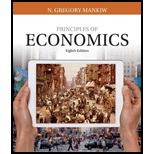
Subpart (a):
The money supply of the economy.
Subpart (a):
Explanation of Solution
The Federal Reserve is the central bank of the US economy, and it is usually known as the Fed. The Fed has the responsibility to keep the economy controlled from the fluctuations, and it has to control the money supply of the economy through its
It is given that the economy contains 2,000 bills that have a value of $1 each. So, the
Concept introduction:
Money: It is any item that is accepted as the payment for the goods and services by the economy.
Banks: They are the financial institutions that accept the deposits of money from the general public and use this money to provide loans to the public.
Fed: It is the central bank of the US, and it has the responsibility of controlling the economy.
Subpart (b):
The money supply of the economy.
Subpart (b):
Explanation of Solution
The banks hold all the deposits as the excess reserves and people deposit all the currency with the banks, then the total deposits with the bank becomes $2,000, and since no loan is provided by the banks, the total reserves of the economy remain the same, which means that the total quantity of money in the economy remains as $2,000 itself. No new money is created.
Concept introduction:
Money: It is any item that is accepted as the payment for the goods and services by the economy.
Banks: They are the financial institutions that accept the deposits of money from the general public and use this money to provide loans to the public.
Fed: It is the central bank of the US, and it has the responsibility of controlling the economy.
Subpart (c):
The money supply of the economy.
Subpart (c):
Explanation of Solution
In the case when people hold $1,000 with them and deposits the remaining $1,000 with the banks where the banks maintain 100 percent reserves and nothing is provided as loans to the public, there will be no new currency generated and thus the total quantity of money in the economy will be the summation of the currency held by the public and the currency held by the banks. Thus, it remains the same $2,000.
Concept introduction:
Money: It is any item that is accepted as the payment for the goods and services by the economy.
Banks: They are the financial institutions that accept the deposits of money from the general public and use this money to provide loans to the public.
Fed: It is the central bank of the US, and it has the responsibility of controlling the economy.
Subpart (d):
The money supply of the economy.
Subpart (d):
Explanation of Solution
In the case when the banks have only 10 percent reserves and use the remaining to provide loans to the public, there will be a multiplier effect on the money supply and the multiplier value can be calculated as follows:
So, the value of the money multiplier in the economy is 10. Thus, when the people hold all the money as demand deposits with the banks, the banks use the money to create new money. Thus, the total money supply increases by the multiplier times, which can be calculated as follows:
Thus, the total money supply in the economy will be $20,000.
Concept introduction:
Money: It is any item that is accepted as the payment for the goods and services by the economy.
Banks: They are the financial institutions that accept the deposits of money from the general public and use this money to provide loans to the public.
Fed: It is the central bank of the US, and it has the responsibility of controlling the economy.
Subpart (e):
The money supply of the economy.
Subpart (e):
Explanation of Solution
In the case when the people hold equal amount of currency with them and with the bank
as demand deposits, since the reserve requirement ratio is 10 percent, in order to calculate the quantity of money, the following two equations must be satisfied:
and
We can substitute the first equation in the second equation as follows:
Thus, the deposits held with the banks are $1818.18. Since the public hold equal money with them and with the banks, the people will hold the same quantity with them which is $1818.18. Thus, the total quantity of money can be calculated by summating the two as follows:
Thus, the total quantity of money in the economy is equal to $3636.36.
Concept introduction:
Money: It is any item that is accepted as the payment for the goods and services by the economy.
Banks: They are the financial institutions that accept the deposits of money from the general public and use this money to provide loans to the public.
Fed: It is the central bank of the US, and it has the responsibility of controlling the economy.
Want to see more full solutions like this?
Chapter 29 Solutions
Principles of Economics (MindTap Course List)
 Essentials of Economics (MindTap Course List)EconomicsISBN:9781337091992Author:N. Gregory MankiwPublisher:Cengage Learning
Essentials of Economics (MindTap Course List)EconomicsISBN:9781337091992Author:N. Gregory MankiwPublisher:Cengage Learning Brief Principles of Macroeconomics (MindTap Cours...EconomicsISBN:9781337091985Author:N. Gregory MankiwPublisher:Cengage Learning
Brief Principles of Macroeconomics (MindTap Cours...EconomicsISBN:9781337091985Author:N. Gregory MankiwPublisher:Cengage Learning

 Principles of Economics (MindTap Course List)EconomicsISBN:9781305585126Author:N. Gregory MankiwPublisher:Cengage Learning
Principles of Economics (MindTap Course List)EconomicsISBN:9781305585126Author:N. Gregory MankiwPublisher:Cengage Learning Principles of Macroeconomics (MindTap Course List)EconomicsISBN:9781305971509Author:N. Gregory MankiwPublisher:Cengage Learning
Principles of Macroeconomics (MindTap Course List)EconomicsISBN:9781305971509Author:N. Gregory MankiwPublisher:Cengage Learning





